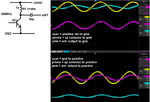pgib8
Member level 2
I'm looking at a simple FM transmitter output (see picture). It is from the collector of a transistor and it goes through a DC blocking capacitor before the antenna would be connected. The entire circuit is floating from true ground. I'm thinking of making the antenna a dipole and suddenly I'm stumbled whether to make the other leg the circuit GND or positive rail. The supply voltage is 3VDC and the RF signal is about 1.8Vpp 100MHz. Part of me thinks that the main antenna port will be floating somewhere between GND and VCC. The other part of me thinks that the DC blocking capacitor will be a low impedance at RF so that the RF is actually "pushing against" GND or VCC but I don't know which one. I also know that if I didn't make it a dipole, the one antenna lead would form a capacitor back to the circuit to complete the circuit, again I don't know if it's to GND or VCC, for some reason I just can't wrap my head around this. I thought maybe I measure it with an oscilloscope, I even tried to clip the ground leads from the scope to VCC or GND trying to figure this out but I think the 1M-Ohm probes just pull the RF to one or the other.
I hope someone can help me understand this and I would really appreciate any help.
I hope someone can help me understand this and I would really appreciate any help.
